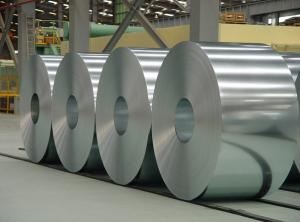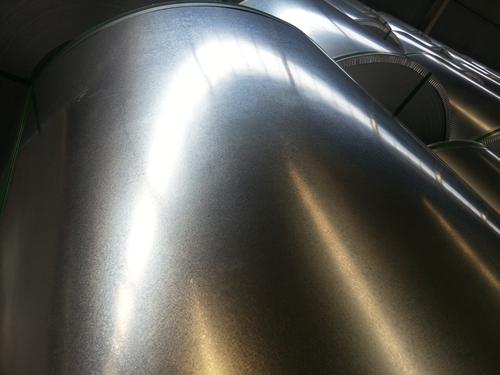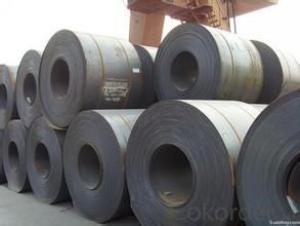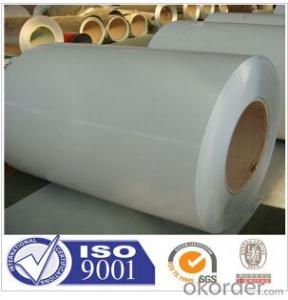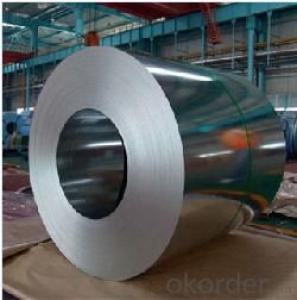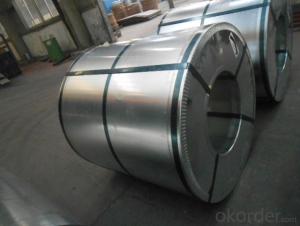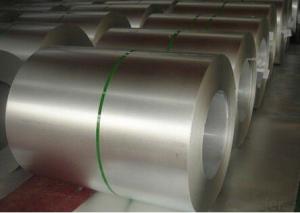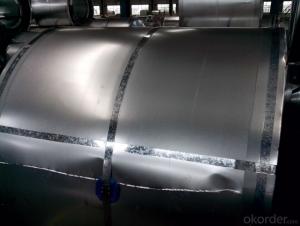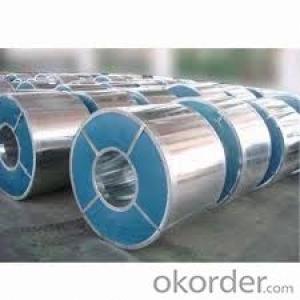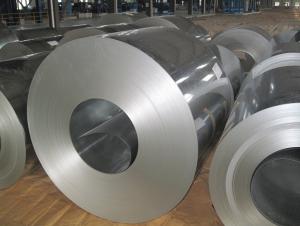Hot dipped galvanized steel coils
- Loading Port:
- China Main Port
- Payment Terms:
- TT OR LC
- Min Order Qty:
- -
- Supply Capability:
- -
OKorder Service Pledge
OKorder Financial Service
You Might Also Like
Commodity | Hot dip galvanized steel coil and sheet |
Technical Standard: | JIS 3302 / ASTM A653 / EN10143 |
Grade | DX51D / DX52D/ DX53D/ S250,280,320GD |
Types: | Commercial / Drawing / Deep Drawing / Structural quality |
Width | 500/650/726/820/914/1000/1200/1219/1220/1250mm |
Thickness | 0.12-2.8mm |
Type of coating: | Galvanized |
Zinc coating | Z30-275g/m2 |
Surface Treatment | Chromed / Skin-pass/ Oiled/Slightly Oiled/ Dry/ Anti-fingerprint |
Surface structure: | Zero spangle / minimized spangle / regular spangle/ big spangle |
ID coil | 508mm or 610mm |
Coil weight | 3-8 MT per coil |
Package: | Properly packed for ocean freight exportation in 20''containers |
Application: | Industrial panels, roofing and siding for painting |
Price terms | FOB,CFR,CIF |
Payment terms | T/T or L/C |
Delivery time | Within 30 days |
Remarks | Insurance is all risks |
MTC will be handed on with shipping documents | |
We accept the third party certification test,such as SGS/BV |
Technical data :
Hot dipped galvanized coil Technical Data
Chemical Composition | ||||||
GRADE | C | Si | Mn | P | S | Ti |
SGCC/DX51D+Z | ≤0.10 | ≤0.50 | ≤0.60 | ≤0.10 | ≤0.030 | ≤0.020 |
DX52D+Z | ≤0.10 | ≤0.50 | ≤0.60 | ≤0.10 | ≤0.030 | ≤0.020 |
SGCD/DX53D+Z | ≤0.10 | ≤0.30 | ≤0.50 | ≤0.05 | ≤0.030 | ≤0.020 |
SGCE/DX54D+Z | ≤0.10 | ≤0.30 | ≤0.30 | ≤0.03 | ≤0.020 | ≤0.020 |
DX56D+Z | ≤0.10 | ≤0.30 | ≤0.30 | ≤0.03 | ≤0.020 | ≤0.020 |
Structural | ≤0.20 | ≤0.60 | ≤1.70 | ≤0.10 | ≤0.045 | |
|
|
|
|
|
| |
Hot dipped galvanized steel coil Mechanical Properties | |||
GRADE | Yield Strength MPa | Tensile Strength MPa | Elongation % |
SGCC(DX51D+Z) | ≥205 | ≥270 | - |
SGCD(DX53D+Z) | - | ≥270 | 38 |
SGCE(DX54D+Z) | - | ≥270 | 40 |
DX56D+Z | - | ≥270 | 42 |
- Q: How are steel coils used in the manufacturing of oil and gas equipment?
- Steel coils are used in the manufacturing of oil and gas equipment as they provide strength and durability to withstand harsh conditions. These coils are often shaped and welded to create various components such as pipes, tanks, and pressure vessels. Additionally, steel coils are also used in the fabrication of structural frames and supports for oil and gas equipment, ensuring stability and reliability in the industry.
- Q: How are steel coils coated?
- Steel coils are coated using a process called coil coating, where a thin layer of protective material such as paint, plastic, or zinc is applied to the surface of the steel coil. This can be done through various methods including roll coating, spray coating, or electroplating, depending on the desired coating material and application.
- Q: What is the type of stainless steel used in knifes.
- If your talking about a folding pocket knife, I think that it's basically six one way and a half dozen the other. I actually do prefer stainless for my pocket knives. I don't want to oil a knife to the degree I feel carbon requires, only to then stick it my pocket to attract dirt to the knife and oil to my pants. I'm the exact opposite on sheath knives though. I like 1095 carbon steel, plain edge sheath knives. I'll thrash on them HARD, and I rarely have major edge problems. Of course, I require them to be coated with some kind of powder coat or the like, because they can rust, but I do try and keep them clean and dry when in the sheath, so they won't pit the uncoated edge. My reasons for this sheath knife preference is multi-fold. First, these knives are simply affordable. I don't spend $80 dollars on a outdoors sheath knife. I use the tool too hard to want to spend more. I don't like the more traditional stainless steels such as AUS-8, 420HC, and 440C (not to mention the HORRENDOUS 440A) because I feel that the all else being equal, a stainless blade will bend before a carbon blade will break. I also think that carbon holds an edge at least as well, if not better, than traditional stainless, and it's much easier to hone. I don't know much about these new laminates, other than the very hard, but not so tough. They seem to be POSSIBLY too brittle for my use. That, combined with the fact that they cost a FORTUNE, means that I just won't be considering them.
- Q: Which one has more electrical resistivity? Wood or steel? And why?I know that the resistivity depends on the material of the conductor, but i want a perfect explaination please.Thnx in advance :)
- Steel is a conductor while wood is an insulator. There are no free electrons available in wood for conduction of electricity to take place. So wood has more electrical resistivity than that of steel.
- Q: Iron melts faster when there will be low carbon in Iron.During steel making the molten Iron gets purified and alloying being done through the process. How the carbon is being controlled at Iron melting stage and what it is called?
- It's not really that hard. You can use your charcoal grill to do it. First build a large fire in it and then bury the steel in the coals. It'll only take about ten minuites or so for the steel to heat through. Then pick it out of the coals with tongs and drop it into a bucket of water. Repeat as desired. Eventually it'll get as brittle as glass. To fix this, you must anneal the metal. Again heat the metal in the coals, only this time let it stay there until the coals go all the way out all by themselves. Next day when all the way cool, Take it out and clean it off. Viola!, you have hardened steel.
- Q: Can steel coils be used in architectural applications?
- Yes, steel coils can be used in architectural applications. Steel coils are commonly used in the construction industry due to their strength, durability, and versatility. They can be shaped, formed, and fabricated into various architectural components such as roofs, walls, facades, and structural elements. Additionally, steel coils can be coated or painted to enhance their aesthetic appeal and protect them from corrosion, making them a popular choice in architectural designs.
- Q: the comparison needed between other steel
- BECAUSE IT HAS HIGH STRENGTH. IT HAS HIGH TOUGHNESS IT HAS LOW PERCENTAGE OF CARBON 0.05% TO 0.30% CAN BE USED AS GEARS,CRANKSHAFT
- Q: What are the safety precautions to be followed while handling steel coils?
- To prevent accidents and injuries when dealing with steel coils, it is crucial to adhere to specific safety measures. Here are some safety measures that must be observed: 1. Personal Protective Equipment (PPE): Always wear suitable PPE, including safety glasses, gloves, steel-toed boots, and hard hats. These items serve to shield you from potential dangers such as falling objects, sharp edges, and chemicals. 2. Proper Lifting Techniques: Employ correct lifting techniques to avoid strains and back injuries. Lift using your legs, not your back, and refrain from making sudden or twisting movements while handling the coils. If the coils are excessively heavy or cumbersome to lift manually, resort to mechanical lifting equipment such as forklifts or cranes. 3. Secure Storage: Ensure that steel coils are stored securely and stably to prevent them from falling or rolling over. Make use of appropriate racks, shelves, or storage containers specifically designed for steel coils. Keep the storage area clean, organized, and devoid of obstructions. 4. Handling Tools: Utilize appropriate handling tools like coil hooks, lifting clamps, or coil tongs to firmly grasp the steel coils. Avoid using makeshift or improper tools, as they can cause the coils to slip, leading to accidents. 5. Secure Transportation: Prior to transporting steel coils, ensure that they are adequately secured on the truck or flatbed. Utilize suitable tie-downs, straps, or chains to prevent the coils from shifting or falling during transit. Adhere to all transportation regulations and guidelines to ensure safe transportation. 6. Awareness of Surroundings: Maintain awareness of your surroundings and the presence of other workers or equipment in the vicinity. Keep a safe distance from moving machinery, forklifts, or other vehicles to avoid collisions or accidents. 7. Hazard Communication: Train all employees handling steel coils on proper safety procedures and ensure that they comprehend the potential hazards involved. Display safety signs or labels to indicate the presence of heavy loads or hazardous materials. 8. Regular Maintenance: Regularly inspect and maintain equipment such as lifting devices or storage racks to ensure they are in proper working condition. Promptly report any defects or malfunctions to the relevant personnel for repairs. By adhering to these safety precautions, the risk of accidents, injuries, and damage when handling steel coils can be minimized. Prioritizing safety in the workplace is crucial to safeguarding yourself and your colleagues.
- Q: so my parents gave me stainless steel cookware for christmas and the first time i used it i cooked chicken. it stuck to the pan and where the oil splattered it cooked on and turned it dark black and brownish. and the bottom too. i don't cook with it because i don't want to burn it on anymore but i don't know how to clean it. how do i cook without burning anything, aside from a lower flame and how on earth do i get the stains on. i've tried almost everything too! thanks.
- Dear pwrgrlmanda, I also use stainless steel. I have found the best way to clean any cookware that has food baked or cooked on it is by filling my sink with the hottest water possible, submerging the entire piece of cookware in the sink and then liberally sprinkling cascade powder over the top. Allow it to set overnight and usually in the morning everything will come off with a nylon scrubber. It really works! No more elbow grease. This also works for corning ware, glass baking pans, cookie sheets etc. Hope it works for you.
- Q: Bronze came before steel, right? thanks
- Bronze The earliest surviving iron artifacts, from the 5th millennium BC in Iran and 2nd millennium BC in China, were made from meteoric iron-nickel. By the end of the 2nd millennium BC iron was being produced from iron ores from South of the Saharan Africa to China. Steel (with a smaller carbon content than pig iron but more than wrought iron) was first produced in antiquity. New methods of producing it by carburizing bars of iron in the cementation process were devised in the 17th century. In the Industrial Revolution, new methods of producing bar iron without charcoal were devised and these were later applied to produce steel. In the late 1850s, Henry Bessemer invented a new steelmaking process, involving blowing air through molten pig iron, to produce mild steel. This and other 19th century and later processes have led to wrought iron no longer being produced. The earliest tin-alloy bronzes date to the late 4th millennium BC in Susa (Iran) and some ancient sites in China, Luristan (Iran) and Mesopotamia (Iraq).
Send your message to us
Hot dipped galvanized steel coils
- Loading Port:
- China Main Port
- Payment Terms:
- TT OR LC
- Min Order Qty:
- -
- Supply Capability:
- -
OKorder Service Pledge
OKorder Financial Service
Similar products
Hot products
Hot Searches
Related keywords
